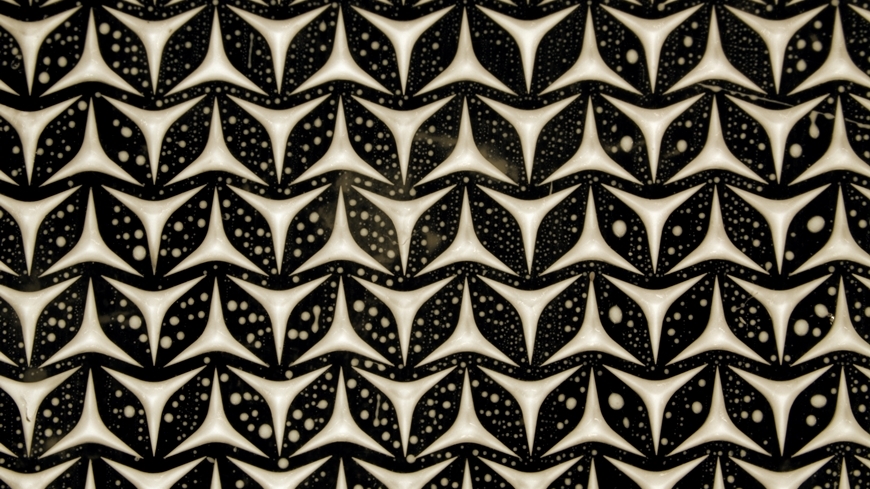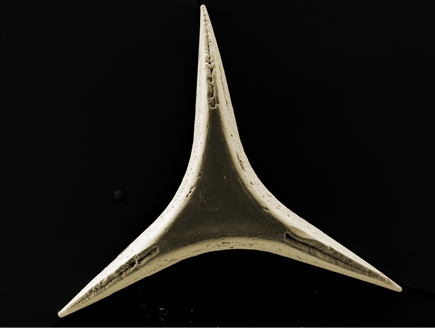Nanoceramics: novel treatment for skin diseases
Stardust in the bathroom
Widespread skin diseases such as psoriasis or neurodermatitis are difficult to treat. Together with an industrial partner, Empa researchers have found an innovative solution: Nanoceramic "stars" create tiny skin lesions and allow therapeutic molecules to reach their site of action.

When material scientists look into the stars, they may be able to recognize the future – namely when it comes to stars made of nanoceramics. Empa researchers in Dübendorf and Thun are working with industry partner Aldena Therapeutics to develop innovative treatment methods for widespread skin diseases. The team is focusing on nanoceramic stars that "go through the skin". The project is funded by Innosuisse, the Swiss innovation promotion agency.
Delivering therapies into the skin

The problem is that modern active ingredients do not penetrate deep enough into affected skin layers if they are applied in conventional ointments or lotions. However, if the skin could be made permeable for a short time, the large therapeutically active molecules could be delivered to their target site. For instance, siRNA molecules, short for small interfering RNA, are being used for new therapies. These molecules can help regulate protein production through targeted interactions with the body's own messenger RNA (mRNA). As such, they can intervene in disease progression and block damaging processes. Drugs with this mode of action already exist for some metabolic disorders and hereditary diseases.
For the application of such siRNAs in modern therapies, Aldena Therapeutics, based in Boston, London and Lausanne, was looking for an effective method to deliver active ingredients into – or rather: under – the skin. Empa researchers Michael Stuer from the High Performance Ceramics laboratory and Patrick Hoffmann from the Advanced Materials Processing laboratory therefore used nanoceramics made of aluminum oxide particles to create a three-dimensional, sharp-edged shape. After sintering, three-armed stars with a diameter of around 0.8 millimeters were created, which can be used to temporarily open the skin barrier for the siRNA molecules. "The 3D stars with tapered arms create micro-wounds in the skin that quickly close on their own," explains Stuer. However, there is still enough time for the active ingredient to penetrate the skin.
Cost-efficient and sustainable

In the StarCURE project, the Empa team succeeded in producing the stars curved at a precise angle. In this way, the stars "roll" over the skin when applied, quickly tilting and thus creating more micro-openings in the skin than flat structures. The nanoceramic stars are applied in a gel. The excess is removed a few seconds after application. Michael Stuer, who has tested the star-containing gel himself, confirms the testimony of previous test subjects: "It feels like a skin scrub".
Another decisive factor for its use as a therapy was a cost-efficient manufacturing process. If the stars had to be produced using a laser process, for example, the manufacturing price would not deliver a viable product. Without further ado, the Empa researchers developed polymer casting molds with which large quantities can be manufactured much more quickly and easily. With this upscaling to industrial scale, it is possible to significantly reduce manufacturing costs. The researchers recently filed a patent application for the process.
Gentle application
But the Empa team and Aldena Therapeutics want to go even further: In the next step, Stuer wants to change the recipe so that the nanoceramic stars become biodegradable or disintegrate after use. In the future, the current ceramic material could be bound to a biopolymer or replaced by a bioglass. This would significantly expand the field of application. "Patients could simply wash the stars off after application," says Stuer.
And finally, the field of application is not limited to skin diseases. One example: Up to 30 percent of all children and young adults suffer from injection phobia. Administering a drug by injection to those affected causes them great anxiety and even fainting. In everyday medical practice, this is a challenge for everyone involved. According to the Empa researcher, the nanoceramic stars could also be a good solution for these people to be supplied with the necessary medication or vaccines easily and without pricks.
Chronic skin conditions
Widespread chronic skin diseases like psoriasis, eczema and atopic dermatitis, the pigmentation disorder vitiligo or white spot disease and circular hair loss (alopecia areata) are difficult to treat. The cause of these conditions is not always fully understood. In addition to hereditary predispositions, environmental exposures induce inflammatory processes in the skin, leading to the symptoms. Depending on the clinical picture, this leads to redness, scaling or loss of pigment or hair. Depending on the severity, the diseases can significantly reduce the quality of life of those affected.
Dr. Michael Stuer
High-Performance-Ceramics
Phone +41 58 765 4183
Open Lab Day
On September 14, 2024, Empa Dübendorf will open the doors of its laboratories to the public. At over 70 stations, visitors will be able to experience current Empa research live on topics such as climate change, the energy transition, human and environmental health and much more. The stories in this issue give a small taste of the variety of materials and technologies that are discovered, researched, and developed in Empa's laboratories. Hungry for more? Visit us on September 14!
Read the latest EmpaQuarterly online or download the PDF version.
-
Share







